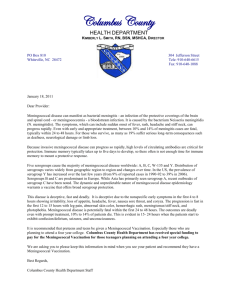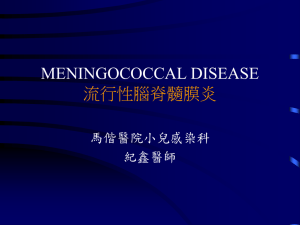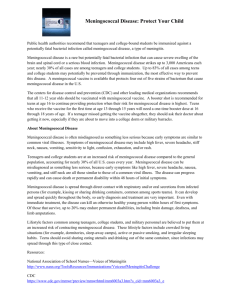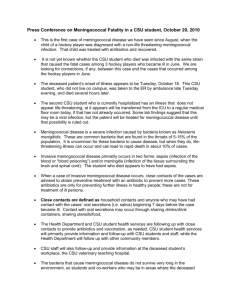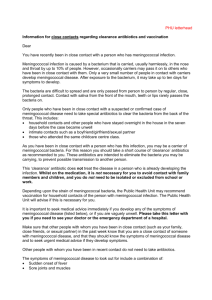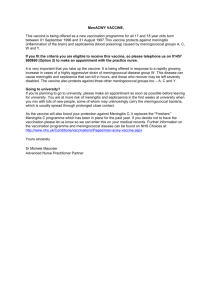20-ayf_lesson_plan_secondary_school
advertisement
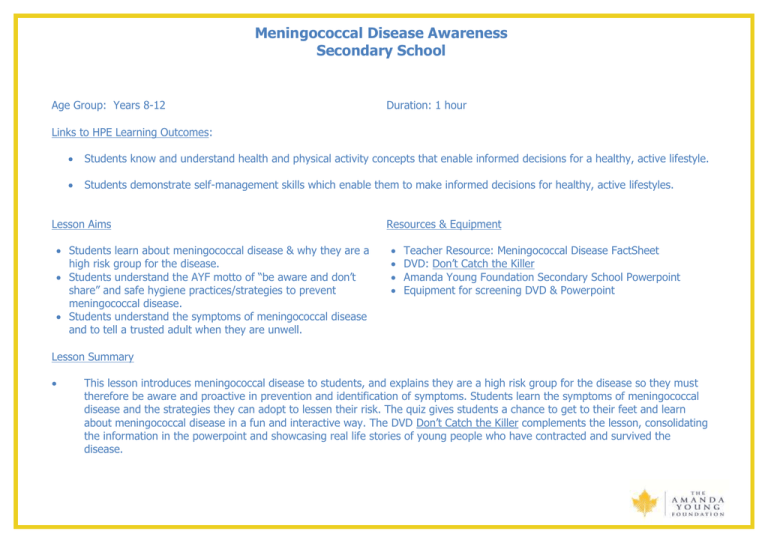
Meningococcal Disease Awareness Secondary School Age Group: Years 8-12 Duration: 1 hour Links to HPE Learning Outcomes: Students know and understand health and physical activity concepts that enable informed decisions for a healthy, active lifestyle. Students demonstrate self-management skills which enable them to make informed decisions for healthy, active lifestyles. Lesson Aims Students learn about meningococcal disease & why they are a high risk group for the disease. Students understand the AYF motto of “be aware and don’t share” and safe hygiene practices/strategies to prevent meningococcal disease. Students understand the symptoms of meningococcal disease and to tell a trusted adult when they are unwell. Resources & Equipment Teacher Resource: Meningococcal Disease FactSheet DVD: Don’t Catch the Killer Amanda Young Foundation Secondary School Powerpoint Equipment for screening DVD & Powerpoint Lesson Summary This lesson introduces meningococcal disease to students, and explains they are a high risk group for the disease so they must therefore be aware and proactive in prevention and identification of symptoms. Students learn the symptoms of meningococcal disease and the strategies they can adopt to lessen their risk. The quiz gives students a chance to get to their feet and learn about meningococcal disease in a fun and interactive way. The DVD Don’t Catch the Killer complements the lesson, consolidating the information in the powerpoint and showcasing real life stories of young people who have contracted and survived the disease. Lesson Plan Time 2 mins Activity Resources Mental Set (see notes) Ask students to raise their hand to guess what item in the room has the most bacteria on it that can make them really sick. Most students will say the bin, the door handle, their hands, etc, the answer is: their mouths. Our mouths contain on average 500 bacteria. Powerpoint Slide 1 Explain that today’s lesson is about a bacteria that up to 30% of us will be carrying in our mouths right now. The meningococcal bacteria usually lives harmlessly in people’s mouths but occasionally it gets past the immune system and multiplies rapidly, killing within 24 hours. It is a rare disease. 3 mins Introduction Briefly explain why the Amanda Young Foundation was set up. Explain that Amanda contracted Powerpoint Slide 2 meningococcal disease and her parents set up the Foundation to help prevent other young people getting the disease. Talk about how Amanda was a fit and healthy athlete, which shows that this disease is indiscriminate. 7 min Introducing Meningococcal Disease Starting with Slide 3, explain that meningococcal disease is caused by bacteria that is extremely aggressive and can cause death within 24 hours. The disease can strike anybody, anytime but is most common in children and young adults. Because it can kill so quickly it is essential that it is caught early, so everybody needs to know the symptoms. Slide 4: explain why teenagers and young adults are a high risk group for the disease – because they have social lifestyles and come into contact with a large number of people on a regular basis they are more likely to come into contact with the bacteria. When you get older you tend to become more insular – don’t go out to parties as often, have a smaller circle of friends, probably work in environments with less people etc. Slide 5: Go through the topic and elaborate on key points. Explain how having a reduced immunity from a cold or virus can make you more susceptible to bacteria. Elaborate on the “intimate kissing”, explaining that kissing your immediate family or your boyfriend/girlfriend is okay because you have to Powerpoint Slides 3-6 live your life, but the risk increases if they go around “snogging” a lot of people! Slide 6: explain how the majority of patients survive meningococcal disease because of an awareness of symptoms so it was caught early. Explain that if left untreated the end result will always be death – it is not possible to survive meningococcal disease without medical intervention. If the disease is not caused early the likelihood of death increases dramatically. 10 mins Quiz Go through Slide 7, explaining that soon all students will stand to take part in the quiz & they need to choose an answer by striking a particular pose. If a student gets an answer wrong they need to sit down. Those left standing at the end will either win a prize (if it’s a small number) or a round of applause (if there’s a lot of them). Powerpoint Slides 7-15 The quiz runs from Slide 8-15, with the questions getting progressively harder. Question 3 onwards covers topics not yet discussed, which will demonstrate to students how little they know about the disease, and teach them some important facts. Answers – Q1: A, Q2: C, Q3: 400, Q4: A, Q5: B, Q6: C, Q7: C, Q8: C Once all students are again seated, ask them what they have learnt from these questions. If necessary go through some of the topics – such as why they should tell an adult rather than call an ambulance if they suspect meningococcal disease (because the early symptoms mimic less serious illnesses such as a virus or gastro, it’s important that an adult make an informed decision before calling an ambulance.) 25 mins DVD “Don’t Catch the Show “Don’t Catch the Killer” DVD to students. This DVD features young people from Perth talking about Killer” DVD their experiences with meningococcal disease. When the DVD is finished, ask students what they found interesting/important. 5 mins Symptoms Slide 16: Explain that the most deadly form of meningococcal disease is septicaemia because it affects the blood, but both are extremely aggressive diseases. Slide 17: Ask students to raise their hands if they have ever had a 24 hour bug or the ‘flu. Read through the following symptoms and ask them to keep their hand raised if they experienced any of them during their ‘bug’: shivering, chills, nausea, vomiting, painful joints, headache, drowsiness. Most students will Powerpoint Slides 16-18 have their hand up throughout the list. Explain that this is one of the reasons that meningococcal disease is so dangerous – it needs to be diagnosed early but the early symptoms often just resemble a typical bug or gastro. Emphasise that the way they will know it’s something more serious is: The symptoms will worsen very quickly – they will feel worse and worse from hour to hour. They will feel sicker than they ever have before. Their gut instinct will tell them this is something serious. Slide 18: Explain that the rash is a sign that the disease has reached a critical stage – it is actually blood leaking from damaged vessels into the skin. Emphasise that they should never wait for the rash in order to self-diagnose meningococcal disease as by then it could be too late. If they ever have a rash plus some meningococcal symptoms they should seek emergency treatment asap! If they just have a rash but no symptoms it isn’t meningococcal disease – probably just a pimple. 5 mins Treatment & Prevention Powerpoint slides Slide 19: Go through the points, elaborating that they know their bodies and need to trust their instincts. 19-20 Don’t be afraid of making a fuss or being wrong – the best result is that they ARE wrong! Stress that when they are feeling unwell they need to let a trusted adult know so that they can check on them – refer to this tragic case in Queensland where a student died in his bed overnight. If somebody had been checking on him they might have been able to get him help in time. Slide 20: Go through the points, explaining that most of them probably don’t have the C strain vaccination but all babies born after 2003 have, if their parents chose to routinely vaccinate. Explain that even with vaccination we must be vigilant as there is no vaccination for B strain. Talk about the importance of not sharing items that go in the mouth, and to practice high hygiene standards. Don’t sneeze into your hand as you then transfer saliva to door handles, etc, instead sneeze into your elbow very handy if you also need to wipe your nose ;). Emphasise the importance of staying away from crowds when sick with a cold – when your immune system is under stress you are more susceptible to the meningococcal bacteria. Often the disease is preceded by a virus or cold. 5 Summary & Questions Go through summary, elaborating on each point. Ask for questions, referring to the provided fact sheet for clarification or visit www.amandayoungfoundationorg.au for answers you aren’t sure of. Powerpoint Slide 21 Notes Mental Set: a teaching strategy when you start the lesson by posing an interesting question or telling an anecdote to get students set for learning. Extension Activities 1. 2. 3. 4. Complete the AYF activity sheets (word sleuth/crossword) provided as part of this programme. Give students the provided Heinemann Fact Sheet & complete the questions and tasks. Students create a brochure/poster/advertisement warning other young people about meningococcal disease. Invite the school nurse (if there is one available) or a health professional parent or a community health nurse to visit and talk to the class about meningococcal disease and other communicable diseases.
